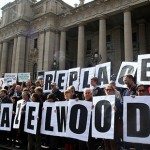By Stephen de Tarczynski
MELBOURNE, Australia, Nov 18 (IPS) – Environmentalists here are on the verge of a significant victory in their efforts to reduce Australia’s greenhouse gas pollution, as the Victorian state government negotiates with the owner of the country’s “dirtiest power station” to shut
down the coal-fired facility.
Cam Walker, spokesman of the green group Friends of the
Earth, says that it has been “a great victory…in that we’ve
moved them in a few short years from a position of extending
the lease, almost indefinitely, to a situation where the
(Victorian) Premier is now saying there will be a staged
closure of the plant.”
The 1600-megawatt Hazelwood power station, located 150
kilometres east of the state capital, Melbourne, produces up
to a quarter of Victoria state’s electricity requirements.
An information war kicked off between environmentalists
and the plant’s owner, International Power, following a 2005
report by conservation group World Wildlife Fund that ranked
Hazelwood the largest carbon dioxide-emitting power station
in the industrialised world.
Campaigners now say that Hazelwood is Australia’s
“dirtiest” power plant, producing in excess of 16 million
tonnes of greenhouse gas pollution each year. Additionally,
they argue the plant is a massive user of water – some 27
billion litres per year – and is the country’s single
biggest emitter of dioxin.
The campaigners say that Hazelwood, first commissioned in
1959, has become outdated and needs to be replaced with
renewable energy technology.
International Power, for its part, argues that the WWF
study was “highly biased” and that “Hazelwood is well down
the list of the world’s CO2 emitting power plants.” It also
rejects claims that the plant is the most polluting in
Australia.
The company, whose global operations outside Australia
include power plants in Pakistan, Thailand and Indonesia in
addition to interests in North America, Europe and the
Middle East, argues that Hazelwood’s actual water usage is
less than half of that claimed by environmentalists and also
denies that the plant emits dangerous pollutants.
International Power purchased the previously state-owned
Hazelwood for 2.35 billion Australian dollars (2.3 billion
U.S. dollars) in 1996 with a 40-year life. The company
admits that the plant releases large volumes of carbon
dioxide – 13 percent of Victoria’s emissions, equating to
three percent of Australia’s total – but it dismisses claims
by green groups that Hazelwood was due to close in 2005 and
was only saved by an extension to its lease.
Instead, the company points to a government-approved
environmental impacts statement which, in 2005, allowed
International Power to move a road and the course of a river
in order to access brown coal reserves at Hazelwood in
return for a 445-million tonne cap on the plant’s total
greenhouse gas emissions.
But with the Victorian government now in preliminary
negotiations with Hazelwood’s owner to shut down a quarter
of the plant by 2014 as part of a process to close the
entire power station in stages, environmentalists are on the
verge of a big win.
Walker told IPS that he is surprised at the campaign’s
seemingly rapid growth. “Just over a year ago, I really
think this wasn’t on the agenda of the state government and
they have come a very long way,” he says.
The Victorian government, led by Premier John Brumby, has
committed to reducing the state’s greenhouse gas emissions
by 20 percent, based on 2000 emission levels, over the next
decade.
While Brumby has sought federal financial backing in
order to compensate International Power for closing
Hazelwood, the Premier says that his government will act “on
our own” if no assistance is forthcoming.
International Power also appears ready to step back from
its investment. The company submitted a plan to the federal
government in 2008 in which it outlined a phased closure of
Australia’s older coal-fired power stations over a 10-year
period “in return for a tariff that reflected the market
value of the asset and reflected the equity invested by the
owners.”
Company spokesman Trevor Rowe says that “nothing has
changed” in International Power’s position since this
submission was made.
While media reports here have suggested that the payout
to International Power will be hundreds of millions of
dollars, Rowe refused to discuss with IPS the amount of
compensation that the company is seeking.
Regardless of the dollar amount that is ultimately paid
to International Power, environmentalists are keen to make
the most of the situation.
“It would represent the first coal-fired power generation
that’s been turned off in Australia for climate change
reasons, so it would be a significant step forward,” says
Mark Wakeham of Environment Victoria, one of a host of green
non-governmental organisations campaigning for the closure
of Hazelwood.
Wakeham, who was involved in early protests against the
power station in 2005, has seen the campaign grow from
actions by local campaigners and environmental groups to a
movement that receives considerable media coverage on the
back of widespread community concern about Australia’s
greenhouse gas pollution.
“I think the Hazelwood campaign has very effectively told
a clear story about what we need to do if we’re going to
reduce greenhouse gas emissions, but also that it’s possible
to do so in a very quick period of time,” he says.
The key to the campaign’s hitherto success has clearly
been its ability to result in tangible outcomes.
“For all the talk on climate change over the last ten
years, we haven’t had governments taking action to stop
polluters polluting. Until that happens, emissions aren’t
going to actually fall,” says Wakeham.






